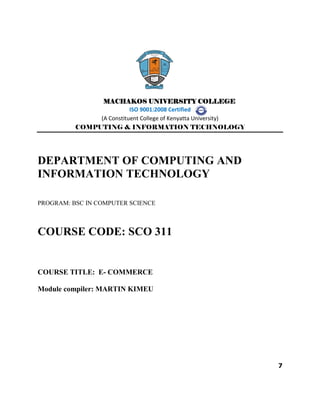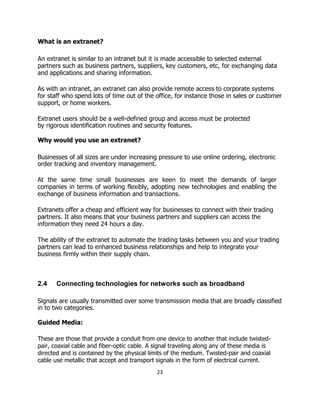The document outlines a comprehensive curriculum for a BSc in Computer Science course focused on e-commerce at Machakos University College. It covers key topics such as the definition and history of e-commerce, enabling technologies, market structures, consumer behavior, internet marketing, security issues, electronic payment systems, and legal considerations. The course aims to equip learners with the necessary knowledge and skills for effective participation in e-business.




















![2.2 Client –server technologies
The client–server model of computing is a distributed application structure that
partitions tasks or workloads between the providers of a resource or service, called
servers, and service requesters, called clients.[1]
Often clients and servers
communicate over a computer network on separate hardware, but both client and
server may reside in the same system. A server machine is a host that is running one
or more server programs which share their resources with clients. A client does not
share any of its resources, but requests a server's content or service function. Clients
therefore initiate communication sessions with servers which await incoming requests.
Description
The client–server characteristic describes the relationship of cooperating programs in an
application. The server component provides a function or service to one or many
clients, which initiate requests for such services.
Functions such as email exchange, web access and database access, are built on the
client–server model. Users accessing banking services from their computer use a web
browser client to send a request to a web server at a bank. That program may in turn
forward the request to its own database client program that sends a request to a
database server at another bank computer to retrieve the account information. The
balance is returned to the bank database client, which in turn serves it back to the
web browser client displaying the results to the user. The client–server model has
become one of the central ideas of network computing. Many business applications
being written today use the client–server model.
21](https://image.slidesharecdn.com/e-commerce-200819202241/85/E-commerce-complete-notes-21-320.jpg)


























































![d) Confidentiality
4 marks each [max 16 marks]
b) Explain the difference between e-Commerce and e-Business [4 marks]
Question 3
EasyMobile is a new Web based Mobile phone company that sells a variety of mobile products
(handsets, contracts and services). The company employs a marketing consultancy to advise
them about developing a successful on-line and off-line marketing promotion before the
official launch of EasyMobile.
Discuss 5 off-line and 5 on-line marketing campaigns for EasyMobile, clearly
indicating the reasons and justifications for each campaign you propose (avoid
general discussion and present relevant campaigns taking into account the requirements of the
company i.e. the products and services they sell and the potential market are they aiming for).
[20 marks]
QUESTION FOUR
a) Mobile commerce has become very popular in Kenya over the recent 3 years. Define
the term Mobile commerce and give reasons for it’s popularity (6 Mks)
b) Explain what needs to be done to retain M-Commerce popularity. (10 Mks)
c) Identify and briefly explain two types of common B2B transactions (4 Mks)
QUESTION FIVE
―EasyFly.Com‖ is a new airline agency that requires an E-Commerce solution. You have
been approached by the company to develop a solution for them. You are aware that
designing and developing an E-Commerce site requires careful planning and selection of
appropriate tools and methodologies. Using E-Commerce Development and Management
Life Cycle (ECDMLC) discuss the stages that you would need to go through to develop and
maintain the site. [20 marks]
79](https://image.slidesharecdn.com/e-commerce-200819202241/85/E-commerce-complete-notes-80-320.jpg)

![“developing”, “established”, “Dedicated” etc, to target communication to customers. Tesco.com have a
touch strategy which includes a sequence of follow-up communications triggered after different events in
a customer‟s lifecycle.
The growth of Tesco has been achieved through a combination of initiatives. Product range development
is one key area. In November 2004, Tesco's introduced a music download service and as the technology
grows, it is hoped that Tesco.com turn into a digital download store of all sorts, rather than just music. In
2007 it launched price comparison site Tesco Compare based on analysis of customer demands
Questions
a). Identify the E-commerce model and E-tailing business model adopted by Tesco [4 marks]
b). In 2006, Tesco launched Tesco Direct to rival catalogue retailers.
Identify the advantages of this approach to
i) Tesco company
ii). Tesco Customers
[6Marks].
c). One of the critical success factors of retailing is customer acquisition and retention.
From the case study identify and the advantages of the Marketing and Advertising
approaches used by Tesco company. [8 Marks]
d). Explain the different security measures that could be taken by Tesco to protect itself and
its online customers [6 Marks]
e). Why is user profile important in e-commerce? Describe three ways to compile user profile. [6 Marks]
QUESTION TWO (20 MARKS)
a) Define the term digital economy. [2 Marks]
b) i) Explain the term electronic marketplace and outline its main components. [9 Marks]
ii) Explain the three main functions of e-markets. [3 Marks]
c) Describe each of the following standards for e-payments:
i) Secure socket layer (SSL)
ii) Transport Layer Security (TLS)
iii) Secure Electronic Transaction (SET) [6 Marks]
QUESTION THREE (20 MARKS)
a) Using a well-labeled diagram, discuss the 3-tier architecture for developing
e-commerce infrastructure. [10 Marks]
b) Explain each of the following security issues:
i) Authorization
81](https://image.slidesharecdn.com/e-commerce-200819202241/85/E-commerce-complete-notes-82-320.jpg)
![ii) Authentication
iii) Auditing
iv) Nonrepudiation
v) Integrity [10 Marks]
QUESTION FOUR (20 MARKS)
a). Explain the four (4) parties usually involved in e-payments. [8 Marks]
b). i) Define the term e-marketing. [2 Marks]
ii) Outline any three characteristics of marketing communications that take place
via the Internet.
[6Marks]
c). Outline any two (2) tangible benefits of EDI. [4 Marks]
QUESTION FIVE (20 MARKS)
Internet and its use in E-Commerce have raised pervasive ethical, social and political issues on a
scale unprecedented for computer technology.
a). Explain the following ethical, social and political issues that have developed around e-commerce
i). Information rights
ii). Property rights
iii). Governance
[6 Marks]
b). When confronted with a situation that seems to present ethical dilemma, outline
how you would analyze and reason about the situation
[8Marks]
(c) Outline three key factors for the success of an E-commerce business. [6 marks]
82](https://image.slidesharecdn.com/e-commerce-200819202241/85/E-commerce-complete-notes-83-320.jpg)
